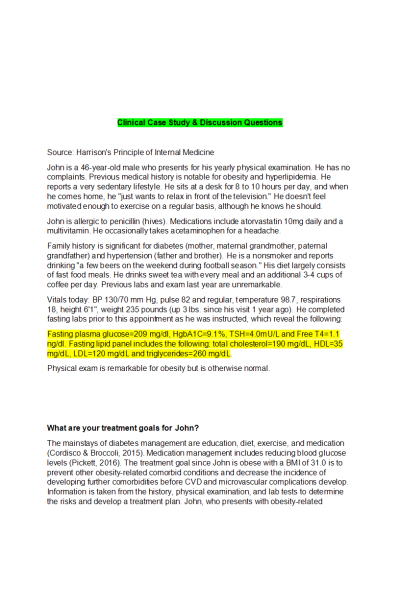NR 566 Week 1 Clinical Case Study Discussion (Original Post with Responses)
-
$15.00
| Institution | NR 566 Advanced Pharmacology for Care of the Family |
| Contributor | Shanzay |
John is a 46-year-old male who presents for his yearly physical examination. He has no complaints. Previous medical history is notable for obesity and hyperlipidemia. He reports a very sedentary lifestyle. He sits at a desk for 8 to 10 hours per day and when he comes home he “just wants to relax in front of the television.” He doesn’t feel motivated enough to exercise on a regular basis, although he knows he should.
John is allergic to penicillin (hives). Medications include atorvastatin 10mg daily and a multivitamin. He occasionally takes acetaminophen for a headache.
Family history is significant for diabetes (mother, maternal grandmother, paternal grandfather) and hypertension (father and brother). He is a nonsmoker and reports drinking “a few beers on the weekend during football season”. His diet largely consists of fast food meals. He drinks sweet tea with every meal and an additional 3-4 cups of coffee per day. Previous labs and exam last year are unremarkable.
Vitals today: BP 130/70 mm Hg, pulse 82 and regular, temperature 98.7, respirations 18, height 6’1”, weight 235 pounds (up 3 lbs. since his visit 1 year ago). He completed fasting labs prior to this appointment as he was instructed which reveal the following:
Fasting plasma glucose=209 mg/dl, HgbA1C=9.1%, TSH=4.0mU/L and Free T4=1.1 ng/dl. Fasting lipid panel includes the following: total cholesterol=190 mg/dL, HDL=35 mg/dL, LDL=120 mg/dL and triglycerides=260 mg/dL.
Physical exam is remarkable for obesity but is otherwise normal.
- What are your treatment goals for John?
- What is your pharmacologic plan and rationale? (cite with appropriate clinical practice guidelines or scholarly, peer-reviewed journals)
- What is the mechanism of action for each drug?
- Please give five medication teaching points for each drug prescribed.
- How would you change the plan if his initial HbgA1C was 14.0 mg/dL and his fasting blood glucose was 350mg/dL along with a urine dipstick that revealed 3+ glucose and + ketones? Provide a detailed alternative plan with the rationale.
| Instituition / Term | |
| Term | Spring 2021 |
| Institution | NR 566 Advanced Pharmacology for Care of the Family |
| Contributor | Shanzay |




































